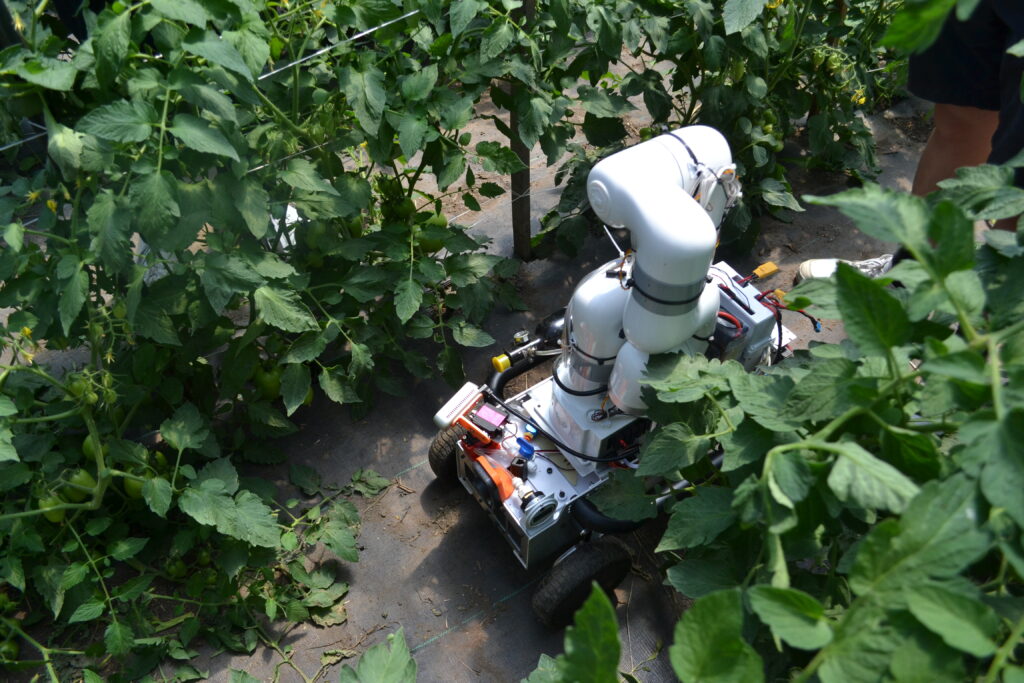An iSEE seed-funded research project that uses robotics and artificial intelligence to autonomously manage “high tunnel” food production is entering its second year at the University of Illinois Sustainable Student Farm.
U. of I.’s Robot Integrated High Tunnels (RobInHighTs) team received a $975,000 USDA NIFA (National Institute of Food and Agriculture) grant in 2023 in addition to an iSEE Campus as a Living Lab (CALL) seed funding that same year.

A RobInHighTs robot uses its camera (orange attachment on left side) to look for signs of pest damage on tomato plants at the Sustainable Student Farm.
High tunnels are metal frames covered in a heavy plastic often used in urban agriculture. Their main benefit is expanding the season that crops can be grown: they can be planted earlier in the spring and harvested later in the fall. In climates like the Midwest, where our ability to grow fresh produce year-round is hindered by the cold weather, this promises to be a huge advantage for local farmers. Additionally, high tunnels often increase crop yields by protecting the plants from severe weather and animals.
“We have seen a lot of interest from local farmers and community gardens to invest in high tunnels to grow specialty crops, but there are a few barriers to entry, like the initial cost of the tunnel and the amount of labor required to maintain the produce while it’s growing,” said Naveen Uppalapati, RobInHighTs’ primary investigator and a research scientist at the Center for Digital Agriculture within the National Center for Supercomputing Applications.
The hope is that RobInHighTs will reduce the amount of labor required, helping local farmers overcome one of those barriers.
The first challenge for the team was ensuring the robots could autonomously navigate between rows of crops. That technology already existed for corn and soybean fields but needed to be adapted for the smaller rows in high tunnels.
Using cameras, the robots monitor parts of the plant looking for signs of pest damage and indications that the plant is ready for harvest.
“Currently, we’re working on detecting pests and making sure that the robot can communicate which plants in the tunnel have signs of pest damage,” Uppalapati said. “That way, the farmer can treat only the plants that need it rather than the whole tunnel, reducing the amount of pesticide used.”
Team members also hope this will have economic benefits by filling in when there are labor shortages. Often, when fruits are mass produced, they all are ready for harvest at one time, and a labor shortage can mean huge amounts of waste simply because they weren’t harvested in time. Shadi Atallah, an associate professor of Agricultural and Consumer Economics, is collaborating with RobInHighTs to measure how many robots would be the equivalent of the amount of work one human can do.
The project’s USDA funding is set to continue through 2026 and has allowed team members to expand their areas of research and collaborate with similar research at Tuskegee University. The goal of that collaboration is to overcome barriers facing minority farmers, and Tuskegee is creating educational modules for this program. The project initially only included one robot to do data collection but now expanded to multiple robots that also do pest detection.
“Our goal for this year is to nail down all of the individual parts: row navigation, pest detection, and harvesting. In the next two years we aim to put them all together and have a robot that can do all that monitoring and send that information to the farmer,” Uppalapati said.
— Article and photos by Erin Minor, iSEE Communications Intern